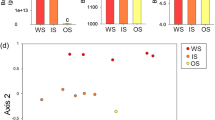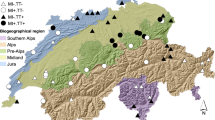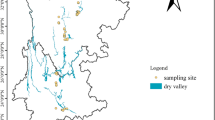Abstract
Dryland (semiarid and arid) ecosystems are responsible for most of the interannual variation in atmospheric CO2 concentrations and contain a considerable fraction of the globe’s soil carbon (C) stock. Despite their important contribution to the global land C sink, we have a poor mechanistic understanding of the processes that drive C cycling patterns in drylands. In this study in eastern Utah, we examined the natural variation of soil C pools and fluxes along semiorthogonal gradients of climate and soil texture in order to determine the pertinent environmental controls on soil C cycling dynamics. Our study revealed a high degree of collinearity among C stocks and fluxes, which were related to climate, vegetation, and soil clay content. Soil C pools were positively correlated with both soil clay content and precipitation, which in turn was linked to aboveground plant biomass. By contrast, enzyme activities were negatively associated with temperature. We observed a strong decoupling of C pools and fluxes (for example, total C, DOC, microbial biomass C, and respiration) from the enzyme activities involved in organic matter decomposition. Overall, our findings indicate that the within- and between-site variation of soil C pools across diverse dryland ecosystems was strongly linked to both climate and edaphic characteristics, but the high degree of local variability within sites could challenge interpretations of environmental controls at broader scales.



Similar content being viewed by others
References
Allison SD. 2006. Soil minerals and humic acids alter enzyme stability: implications for ecosystem processes. Biogeochemistry 81:361–73.
Allison SD, Wallenstein MD, Bradford MA. 2010. Soil-carbon response to warming dependent on microbial physiology. Nature Geoscience 3:336–40.
Amelung W, Lobe I, Du Preez CC. 2002. Fate of microbial residues in sandy soils of the South African Highveld as influenced by prolonged arable cropping. European Journal of Soil Science 53:29–35.
Austin AT, Yahdjian L, Stark JM, Belnap J, Porporato A, Norton U, Ravetta DA, Schaeffer SM. 2004. Water pulses and biogeochemical cycles in arid and semiarid ecosystems. Oecologia 141:221–35.
Bai Y, Wu J, Xing Q, Pan Q, Huang J, Yang D, Han X. 2008. Primary production and rain use efficiency across a precipitation gradient on the Mongolia plateau. Ecology 89:2140–53.
Beer C, Reichstein M, Tomelleri E, Ciais P, Jung M, Carvalhais N, Rödenbeck C, Arain MA, Baldocchi D, Bonan GB, Bondeau A, Cescatti A, Lasslop G, Lindroth A, Lomas M, Luyssaert S, Margolis H, Oleson KW, Roupsard O, Veenendaal E, Viovy N, Williams C, Woodward FI, Papale D. 2010. Terrestrial gross carbon dioxide uptake: global distribution and covariation with climate. Science 329:834–8.
Bond-Lamberty B, Thomson A. 2010. Temperature-associated increases in the global soil respiration record. Nature 464:579–82.
Borken W, Matzner E. 2009. Reappraisal of drying and wetting effects on C and N mineralization and fluxes in soils. Global Change Biology 15:808–24.
Bradford MA, Berg B, Maynard DS, Wieder WR, Wood SA. 2016. Understanding the dominant controls on litter decomposition. Journal of Ecology 104:229–38.
Brookes PC, Landman A, Pruden G, Jenkinson DS. 1985. Chloroform fumigation and the release of soil nitrogen: a rapid direct extraction method to measure microbial biomass nitrogen in soil. Soil Biology and Biochemistry 17:837–42.
Broxton PD, Zeng X, Scheftic W, Troch PA. 2014. A MODIS-based global 1-km maximum green vegetation fraction dataset. Journal of Applied Meteorology and Climatology 53:1996–2004.
Cable JM, Ogle K, Williams DG, Weltzin JF, Huxman TE. 2008. Soil texture drives responses of soil respiration to precipitation pulses in the sonoran desert: implications for climate change. Ecosystems 11:961–79.
Carey JC, Tang J, Templer PH, Kroeger KD, Crowther TW, Burton AJ, Dukes JS, Emmett B, Frey SD, Heskel MA, Jiang L, Machmuller MB, Mohan J, Panetta AM, Reich PB, Reinsch S, Wang X, Allison SD, Bamminger C, Bridgham S, Collins SL, de Dato G, Eddy WC, Enquist BJ, Estiarte M, Harte J, Henderson A, Johnson BR, Larsen KS, Luo Y, Marhan S, Melillo JM, Peñuelas J, Pfeifer-Meister L, Poll C, Rastetter E, Reinmann AB, Reynolds LL, Schmidt IK, Shaver GR, Strong AL, Suseela V, Tietema A. 2016. Temperature response of soil respiration largely unaltered with experimental warming. Proceedings of the National Academy of Sciences USA 113:13797–802.
Carvalhais N, Forkel M, Khomik M, Bellarby J, Jung M, Migliavacca M, Mu M, Saatchi S, Santoro M, Thurner M, Weber U, Ahrens B, Beer C, Cescatti A, Randerson JT, Reichstein M. 2014. Global covariation of carbon turnover times with climate in terrestrial ecosystems. Nature 514:213–17.
Chen S, Huang Y, Zou J, Shi Y. 2013. Mean residence time of global topsoil organic carbon depends on temperature, precipitation and soil nitrogen. Global Planetary Change 100:99–108.
Collins SL, Belnap J, Grimm NB, Rudgers JA, Dahm CN, D’Odorico P, Litvak M, Natvig DO, Peters DC, Pockman WT, Sinsabaugh RL, Wolf BO. 2014. A multiscale, hierarchical model of pulse dynamics in arid-land ecosystems. Annual Review of Ecology, Evolution, and Systematics 45:397–419.
Davidson EA, Janssens IA. 2006. Temperature sensitivity of soil carbon decomposition and feedbacks to climate change. Nature 440:165–73.
Delgado-Baquerizo M, Maestre FT, Gallardo A, Bowker MA, Wallenstein MD, Quero JL, Ochoa V, Gozalo B, García-Gómez M, Soliveres S, García-Pelacios P. 2013. Decoupling of soil nutrient cycles as a function of aridity in global drylands. Nature 502:672.
Doane TA, Horwáth WR. 2003. Spectrophotometric determination of nitrate with a single reagent. Analytical Letters 36:2713–22.
Don A, Schumacher J, Freibauer A. 2011. Impact of tropical land-use change on soil organic carbon stocks—a meta-analysis. Global Change Biology 17:1658–70.
Feng X, Simpson AJ, Simpson MJ. 2005. Chemical and mineralogical controls on humic acid sorption to clay mineral surfaces. Organic Geochemistry 36:1553–66.
Fierer N, Schimel JP. 2002. Effects of drying–rewetting frequency on soil carbon and nitrogen transformations. Soil Biology and Biochemistry 34:777–87.
Fox J, Weisberg S. 2011. An R companion to applied regression. Thousand Oaks, CA: Sage Publications.
Gee GW, Bauder JW. 1979. Particle size analysis by hydrometer: a simplified method for routine textural analysis and a sensitivity test of measurement parameters 1. Soil Science Society of America Journal 43:1004–7.
Gentsch N, Wild B, Mikutta R, Čapek P, Diáková K, Schrumpf M, Turner S, Minnich C, Schaarschmidt F, Shibistova O, Schnecker J, Urich T, Gittel A, Šantrůčková H, Bárta J, Lashchinskiy N, Fuß R, Richter A, Guggenberger G. 2018. Temperature response of permafrost soil carbon is attenuated by mineral protection. Global Change Biology 24:3401–15.
German DP, Weintraub MN, Grandy AS, Lauber CL, Rinkes ZL, Allison SD. 2011. Optimization of hydrolytic and oxidative enzyme methods for ecosystem studies. Soil Biology and Biochemistry 43:1387–97.
Harrison-Kirk T, Beare MH, Meenken ED, Condron LM. 2014. Soil organic matter and texture affect responses to dry/wet cycles: Changes in soil organic matter fractions and relationships with C and N mineralisation. Soil Biology and Biochemistry 74:50–60.
Homer CG, Dewitz JA, Yang L, Jin S, Danielson P, Xian G, Coulston J, Herold ND, Wickham JD, Megown K. 2015. Completion of the 2011 National Land Cover Database for the conterminous United States-Representing a decade of land cover change information. Photogrammetric Engineering and Remote Sensing 81(5):345–54.
Huxman TE, Snyder KA, Tissue D, Leffler AJ, Ogle K, Pockman WT, Sandquist DR, Potts DL, Schwinning S. 2004. Precipitation pulses and carbon fluxes in semiarid and arid ecosystems. Oecologia 141:254–68.
Jobbágy EG, Jackson RB. 2000. The vertical distribution of soil organic carbon and its relation to climate and vegetation. Ecological Applications 10:423–36.
Kätterer T, Reichstein M, Andrén O, Lomander A. 1998. Temperature dependence of organic matter decomposition: a critical review using literature data analyzed with different models. Biology and Fertility of Soils 27:258–62.
Keeney DR, Nelson DW. 1982. Nitrogen - Inorganic Forms. In: Page AL, Ed. Methods of soil analysis, agronomy monograph 9, part 2. Madison, WI: Soil Science Society of America. p 643–98.
Kunkel ML, Flores AN, Smith TJ, McNamara JP, Benner SG. 2011. A simplified approach for estimating soil carbon and nitrogen stocks in semi-arid complex terrain. Geoderma 165:1–11.
Lal R. 2004. Carbon sequestration in dryland ecosystems. Environmental Management 33:528–44.
Lehmann J, Kleber M. 2015. The contentious nature of soil organic matter. Nature 528:60–8.
Liu Z, Shao M, Wang Y. 2011. Effect of environmental factors on regional soil organic carbon stocks across the Loess Plateau region, China. Agriculture, Ecosystems and Environment 142:184–94.
Lloyd J, Taylor JA. 1994. On the temperature dependence of soil respiration. Functional Ecology 8:315–23.
Lobe I, Amelung W, Du Preez CC. 2001. Losses of carbon and nitrogen with prolonged arable cropping from sandy soils of the South African Highveld. European Journal of Soil Science 52:93–101.
Manzoni S, Schaeffer SM, Katul G, Porporato A, Schimel JP. 2014. A theoretical analysis of microbial eco-physiological and diffusion limitations to carbon cycling in drying soils. Soil Biology and Biochemistry 73:69–83.
Meersmans J, De Ridder F, Canters F, De Baets S, Van Molle M. 2008. A multiple regression approach to assess the spatial distribution of Soil Organic Carbon (SOC) at the regional scale (Flanders, Belgium). Geoderma 143:1–13.
Moyano FE, Manzoni S, Chenu C. 2013. Responses of soil heterotrophic respiration to moisture availability: an exploration of processes and models. Soil Biology and Biochemistry 59:72–85.
Müller T, Höper H. 2004. Soil organic matter turnover as a function of the soil clay content: consequences for model applications. Soil Biology and Biochemistry 36:877–88.
Mulvaney RL. 1996. Nitrogen - inorganic forms. In: Sparks DL, Page AL, Helmke PA, Loeppert RH, Soltanpoor PN, Tabatabai MA, Johnston CT, Sumner ME, Eds. Methods of soil analysis, part 3, chemical methods, book series no. 5. Madison, WI: Soil Science Society of America. p 1123–84.
Myneni R, Knyazikhin Y, Park T. 2015. MOD15A2H MODIS/Terra Leaf Area Index/FPAR 8-Day L4 Global 500 m SIN Grid V006 [Data set]. NASA EOSDIS Land Processes DAAC.
Paradis E, Claude J, Strimmer K. 2004. APE: analyses of phylogenetics and evolution in R language. Bioinformatics 20:289–90.
Plante AF, Conant RT, Stewart CE, Paustian K, Six J. 2006. Impact of soil texture on the distribution of soil organic matter in physical and chemical fractions. Soil Science Society of America Journal 70:287–96.
PRISM Climate Group, Oregon State University. http://prism.oregonstate.edu. Accessed 29 June 2017.
Running S, Mu Q, Zhao M. 2015. MOD17A3 MODIS/Terra Gross Primary Productivity Yearly L4 Global 1 km SIN Grid. NASA LP DAAC.
Safriel U, Adeel Z, Niemeijer D, Puigdefabregas J, White R, Lal R, Winslow M, Ziedler J, Prince S, Archer E, King C, Shapiro B, Wessels K, Nielsen T, Portnov B, Reshef I, Thonell J, Lachman E, McNab D. 2005. Dryland Systems. In: Hassan R, Scholes R, Ash N, Eds. Ecosystems and human well-being: current state and trends: findings of the condition and Trends Working Group, Vol. 1. Washington, DC: Island Press. p 625–62.
Schjønning P, Thomsen IK, Moldrup P, Christensen BT. 2003. Linking soil microbial activity to water-and air-phase contents and diffusivities. Soil Science Society of America Journal 67:156–65.
Schmidt MWI, Torn MS, Abiven S, Dittmar T, Guggenberger G, Janssens IA, Kleber M, Kögel-Knabner I, Lehmann J, Manning DAC, Nannipieri P, Rasse DP, Weiner S, Trumbore SE. 2011. Persistence of soil organic matter as an ecosystem property. Nature 478:49–56.
Shao P, Zeng Z, Moore DJP, Zeng X. 2013. Soil microbial respiration from observations and earth system models. Environmental Research Letters 8:034034.
Shen W, Jenerette GD, Hui D, Phillips RP, Ren H. 2008. Effects of changing precipitation regimes on dryland soil respiration and C pool dynamics at rainfall event, seasonal and interannual scales. Journal of Geophysical Research: Biogeosciences 113.
Sims GK, Ellsworth TR, Mulvaney RL. 1995. Microscale determination of inorganic nitrogen in water and soil extracts. Communications in Soil Science and Plant Analysis 26:303–16.
Sinsabaugh RL, Lauber CL, Weintraub MN, Ahmed B, Allison SD, Crenshaw C, Contosta AR, Cusack D, Frey S, Gallo ME, Gartner TB, Hobbie SE, Holland K, Keeler BL, Powers JS, Stursova M, Takacs-Vesbach C, Waldrop MP, Wallenstein MD, Zak DR, Zeglin LH. 2008. Stoichiometry of soil enzyme activity at global scale. Ecology Letters 11:1252–64.
Sinsabaugh RL, Weiland T, Linkins AE. 1992. Enzymic and molecular analysis of microbial communities associated with lotic particulate organic matter. Freshwater Biology 28:393–404.
Six J, Elliott ET, Paustian K. 2000. Soil macroaggregate turnover and microaggregate formation: a mechanism for C sequestration under no-tillage agriculture. Soil Biology and Biochemistry 32:2099–103.
Soil Survey Staff, Natural Resources Conservation Service, United States Department of Agriculture. 2017. Soil Survey Geographic (SSURGO) Database for Grand, Rich, and Uintah Cos., Utah. Available online at https://sdmdataaccess.sc.egov.usda.gov. Accessed on 25 Jan 2017.
Talmon Y, Sternberg M, Grünzweig JM. 2011. Impact of rainfall manipulations and biotic controls on soil respiration in Mediterranean and desert ecosystems along an aridity gradient: Shrubland Soil Respiration And Climate Change. Global Change Biology 17:1108–18.
Tang J, Riley WJ. 2015. Weaker soil carbon–climate feedbacks resulting from microbial and abiotic interactions. Nature Climate Change 5:56–60.
Tietjen T, Wetzel RG. 2003. Extracellular enzyme-clay mineral complexes: enzyme adsorption, alteration of enzyme activity, and protection from photodegradation. Aquatic Ecology 37:331–9.
Tombácz E, Libor Z, Illes E, Majzik A, Klumpp E. 2004. The role of reactive surface sites and complexation by humic acids in the interaction of clay mineral and iron oxide particles. Organic Geochemistry 35:257–67.
Torn MS, Trumbore SE, Chadwick OA, Vitousek PM, Hendricks DM. 1997. Mineral control of soil organic carbon storage and turnover. Nature 389:170–3.
Vance ED, Brookes PC, Jenkinson DS. 1987. An extraction method for measuring soil microbial biomass C. Soil Biology and Biochemistry 19:703–7.
Waldrop MP, Balser TC, Firestone MK. 2000. Linking microbial community composition to function in a tropical soil. Soil Biology and Biochemistry 32:1837–46.
Wang X, Wang J, Xu M, Zhang W, Fan T, Zhang J. 2015. Carbon accumulation in arid croplands of northwest China: pedogenic carbonate exceeding organic carbon. Scientific Reports 5:11439.
Yang Y, Fang J, Tang Y, Ji C, Zheng C, He J, Zhu B. 2008. Storage, patterns and controls of soil organic carbon in the Tibetan grasslands. Global Change Biology 14:1592–9.
Zuur AF, Ieno EN, Elphick CS. 2010. A protocol for data exploration to avoid common statistical problems. Methods in Ecology and Evolution 1:3–14.
Acknowledgements
We would like to thank the Bureau of Land Management (especially, Gabriel Bissonette, Deej Brown, Michelle Brown, Becky Doolittle, Jared Lundell, James Hereford, and Christina Price) for allowing us to collect soil samples from these field sites. In addition, we would like to thank the three anonymous reviewers for their thoughtful feedback on an earlier draft of this manuscript.
Author information
Authors and Affiliations
Corresponding author
Additional information
Author Contributions K.R.S. performed the research and led the writing of the manuscript, with edits by B.G.W.; K.R.S. and B.G.W. analyzed the data and designed the study.
Electronic supplementary material
Below is the link to the electronic supplementary material.
Rights and permissions
About this article
Cite this article
Smith, K.R., Waring, B.G. Broad-Scale Patterns of Soil Carbon (C) Pools and Fluxes Across Semiarid Ecosystems are Linked to Climate and Soil Texture. Ecosystems 22, 742–753 (2019). https://doi.org/10.1007/s10021-018-0299-0
Received:
Accepted:
Published:
Issue Date:
DOI: https://doi.org/10.1007/s10021-018-0299-0




